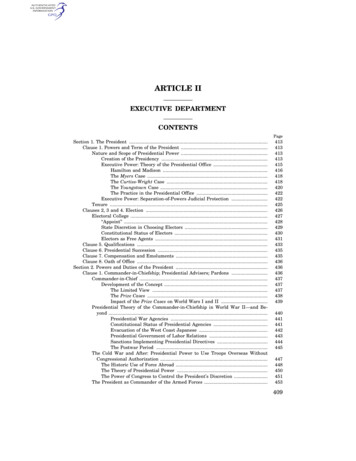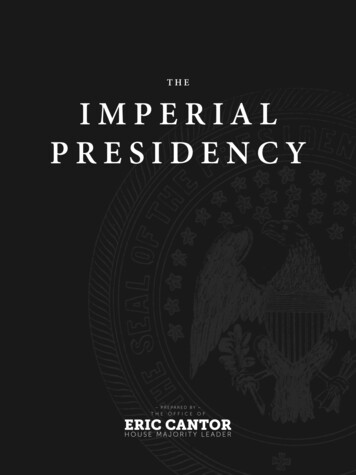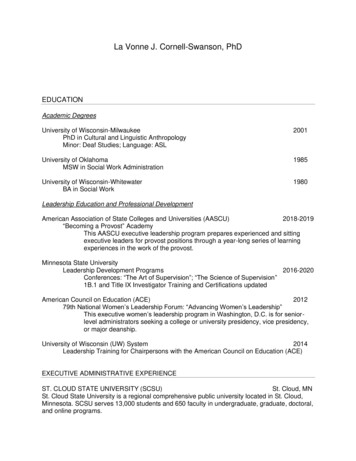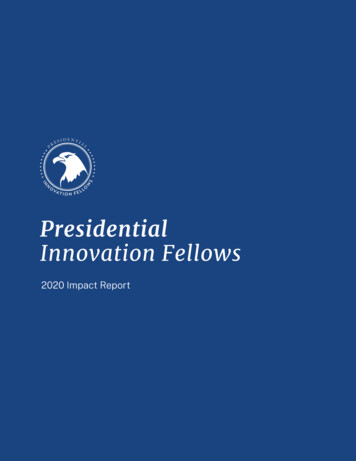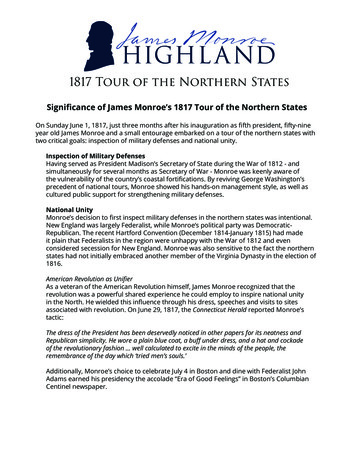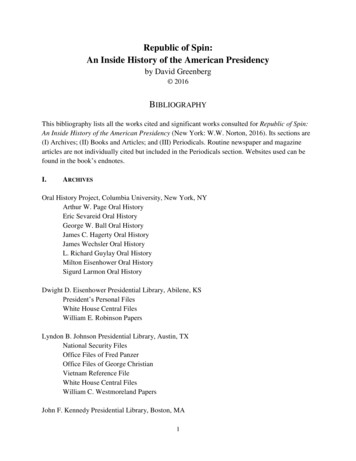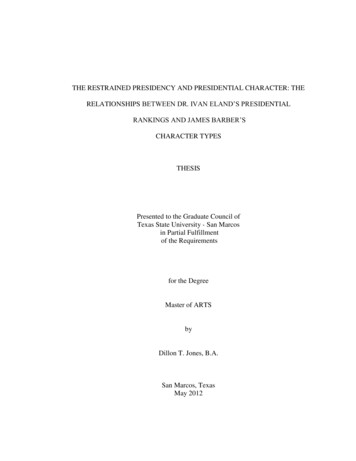
Transcription
THE RESTRAINED PRESIDENCY AND PRESIDENTIAL CHARACTER: THERELATIONSHIPS BETWEEN DR. IVAN ELAND‟S PRESIDENTIALRANKINGS AND JAMES BARBER‟SCHARACTER TYPESTHESISPresented to the Graduate Council ofTexas State University - San Marcosin Partial Fulfillmentof the Requirementsfor the DegreeMaster of ARTSbyDillon T. Jones, B.A.San Marcos, TexasMay 2012
THE RESTRAINED PRESIDENCY AND PRESIDENTIAL CHARACTER: THERELATIONSHIPS BETWEEN DR. IVAN ELAND‟S PRESIDENTIALRANKINGS AND JAMES BARBER‟SCHARACTER TYPESCommittee Members Approved:Theodore Hindson, ChairKenneth WardPatricia ParentApproved:J. Michael WilloughbyDean of the Graduate College
COPYRIGHTbyDillon Tyler Jones2012
FAIR USE AND AUTHOR’S PERMISSION STATEMENTFair UseThis work is protected by the Copyright Laws of the United States (Public Law 94-553,section 107). Consistent with fair use as defined in the Copyright Laws, brief quotationsfrom this material are allowed with proper acknowledgment. Use of this material forfinancial gain without the author‟s express written permission is not allowed.Duplication PermissionAs the copyright holder of this work I, Dillon Tyler Jones, authorize duplication of thiswork, in whole or part, for educational or scholarly purposes only.
ACKNOWLEDGEMENTSThroughout this lengthy process of writing a thesis, there are numerous peoplethat have helped me both directly and indirectly in the thesis process. First, I would liketo thank my parents, Mike and Lisa Jones for raising me well enough to put me in thisposition in the first place. I would also like to thank everyone else I‟m close to includingfriends, family, and of course my fiancée Kristin for their support during the past year.As for those who had a more direct impact on the thesis material, itself, I firstwould like my committee chair, Dr. Hindson, for not only being very helpful in terms ofthe direction of my thesis, but for peaking my interest in the presidency through theundergraduate and graduate courses I have taken from him. I would also like to thank myother committee members, Dr. Ward, for teaching me how to think (not what to think),and Dr. Parent for kindly joining my committee at short notice. I can‟t leave out thankingDr. Ivan Eland, himself, for not only writing the book that my thesis is centered around,but for also giving me the opportunity to discuss his book further in an interview. As forJames Barber, even though I may not fully agree with his presidential characterclassification system, I must thank him for coming up with this system in the first placeor this thesis wouldn‟t be possible.In addition, I thank all of the professors I‟ve taken classes with in the PoliticalScience Department at Texas State University-San Marcos for giving me the food forthought I need to progress my studies. Last, but certainly not least, I would like to thankv
the Political Science office staff for their advice, logistical support, and reminding me toget everything in on time.This manuscript was submitted on March 8, 2012.vi
TABLE OF CONTENTSPageACKNOWLEDGEMENTS .vLIST OF FIGURES .xABSTRACT . xiCHAPTERI. INTRODUCTION .1The Problem and Questions .1Barber‟s Categories .2Eland‟s Criteria .4Themes in Eland‟s Criteria .7Hypotheses .8II. PRIMARY RELATIONSHIPS .12Eland‟s Rankings of Presidential Success .12Barber‟s Categories with Eland‟s Rankings .13Statistical Analysis of Eland‟s Rankings and Scores in Barber‟sCharacter Categories .14Eland/Barber Analysis Conclusions .15Implementing Maranell‟s Presidential Types .18Maranell Classifications with Eland‟s Rank and Score .19Statistical Analysis of Eland‟s Rankings and Scores in Barber andMaranell‟s Combined Character Categories .27BEM Test Conclusions .29BEM Test Exceptions .30III. SECONDARY RELATIONSHIPS .32BEM Presidential Term Comparisons .32Presidential Time Quadrant Scores .36BEM Presidential/Congressional Party Differentials (PCPD) .39The Siena College Presidential Rankings .43vii
IV. THE PRESIDENTS .50Introduction .50George Washington .50John Adams.52Thomas Jefferson .54James Madison .56James Monroe .58John Quincy Adams .59Andrew Jackson .60Martin Van Buren .62John Tyler .64James Polk .65Zachary Taylor .67Millard Fillmore .68Franklin Pierce .70James Buchanan .71Abraham Lincoln .73Andrew Johnson.75Ulysses S. Grant .76Rutherford B. Hayes .78Chester Arthur .79Grover Cleveland .81Benjamin Harrison .83William McKinley .85Theodore Roosevelt .87William Taft .89Woodrow Wilson .90Warren G. Harding.92Calvin Coolidge .94Herbert Hoover .96Franklin D. Roosevelt .98Harry S Truman .101Dwight Eisenhower .103John F. Kennedy .105Lyndon B. Johnson .107Richard Nixon .109Gerald Ford .110James Earl Carter .112Ronald Reagan .114George H. W. Bush .116William Clinton .117George W. Bush .120Barack Obama .122V. CONCLUSION .124viii
REFERENCES .129ix
LIST OF FIGURESFigurePage1. Eland's Rankings of Presidential Success .122. Barber‟s Categories with Eland‟s Rankings .133. Statistical Analysis of Eland‟s Rankings and Scores in Barber‟sCharacter Categories .144. Pederson (Maranell) Classifications with Eland‟s Rank and Scores .195. Statistical Analysis of Eland‟s Rankings and Scores in Maranell‟sCharacter Categories .206. Combined Barber and Maranell Classifications with Eland‟s Rank and Scores .267. Statistical Analysis of Eland‟s Rankings and Scores in Barber and Maranell‟sCombined Character Categories .278. BEM Presidential Term Comparisons .329. Time Quadrant Scores.3610. BEM Presidential/Congressional Party Differentials (PCPD) .3911. Siena College Poll Presidential Rankings .4412. Statistical Analysis of the Siena College Poll Presidential Rankings inBarber and Maranell‟s Combined Character Categories .45x
ABSTRACTTHE RESTRAINED PRESIDENCY AND PRESIDENTIAL CHARACTER: THERELATIONSHIPS BETWEEN DR. IVAN ELAND‟S PRESIDENTIAL RANKINGSAND JAMES BARBER‟S CHARACTER TYPESbyDillon Tyler Jones, B.A.Texas State University - San MarcosSpring 2012SUPERVISING PROFESSOR: THEODORE HINDSONThe goal of this thesis is to take a ranking of American presidents with criteriabased on restraint on presidential power and compare it to James Barber‟s presidentialcharacter classifications. Dr. Ivan Eland‟s book Recarving Rushmore ranks presidentsbased on his notion Constitutional originalism, that is, his conception on how presidentsshould act in terms in the categories of Peace, Prosperity, and Liberty as they relate tohow the founding fathers would expect.xi
Primary tests are done to see if there are any relationships between a presidenthaving a high or low ranking on Eland‟s list and his Barber presidential character type.After these relationships are found, secondary tests are performed to find otherrelationships in terms of number of terms elected, time period of the presidency, andCongressional party in power in relationship to the president‟s party. From part of thesesecondary tests, we can infer that there may be other determining factors outside the saidcriteria of both Eland and Barber that affect their rankings and character classifications ofAmerican presidents.xii
CHAPTER IINTRODUCTIONThe Problem and QuestionsA common thread regarding ranking American presidents seems to includeholding presidents who have severed during crises, war-time, and have passed significantlegislation in high regard. Dr. Ivan Eland takes a very different approach in presidentialranking in his book, Recarving Rushmore, which ranks presidents in terms of his owninterpretations of Peace, Prosperity, and Liberty. Eland generally gives high rankings tothose who avoided using presidential power and expanding the power of the federalgovernment, while giving low rankings to those who expanded both presidential andfederal power. Given this different set of presidential ranking criteria, I set out to seehow high or low rankings using this criteria relates to the labels of presidential charactertypes as defined by James David Barber.In his book, The Presidential Character, James David Barber explains fourdifferent categories that American presidents can be placed under: Active-Positive,Active-Negative, Passive-Positive, and Passive-Negative. He places each president fromTheodore Roosevelt through George H. W. Bush, as well as the first four presidents of theUnited States, into one of these categories. Dr. Ivan Eland ranks every president throughGeorge W. Bush based on how well they uphold Eland‟s version of original intent of theConstitution in terms of policies leading to peace, prosperity, and liberty. Using Eland‟spresidential criteria and Barber‟s character evaluation system, the main question arises:1
2Are there any relationships between Eland‟s higher or lower presidential rankings basedon his conceptions of Peace, Prosperity, and Liberty and Barber‟s presidential charactertypes, and if so, what are those relationships? Along with that question come severalsecondary questions: If there are relationships with exceptions, why do these exceptionsoccur? Since Barber doesn‟t classify all of the presidents, is there another classificationprocedure and ranking made for those missing presidents that can adequately fill in therest of the list? Can any relationships be made between the number of terms a presidentserves and its Barber/Eland category and ranking? Can further relationships be madebetween which time period a president serves and its category and ranking? Are thereany relationships between a united or divided government (political party of the presidentcompared to the ones controlling the House of Representatives and the Senate) and apresident‟s category and ranking? How does Eland's list compare to a more mainstreampresidential Ranking list like the Siena College survey? Are there relationships betweenhigher or lower Siena College rankings and a certain Barber character classification?Barber‟s CategoriesBefore diving into any relationships, it is essential to define James Barber‟scategories for presidential Character. For the Active-Positive presidency, “there is acongruence, a consistency, between being very active and the enjoyment of it, indicatingrelatively high self-esteem and relative success in relating to the environment” (Barber2009, 9). Essentially, the Active-Positive president has no problem in putting forth effortto utilize the power of the presidency and is emotionally rewarded for doing so.
3Examples Barber gives as Active-Positive presidents are Thomas Jefferson and FranklinD. Roosevelt.On the other hand, Barber sees Active-Negative presidents as putting forth thesame intense effort as an Active-Positive president, but without receiving the sameemotional reward. Presidents in this category are ambitious, yet compulsive as if to makeup for something. Barber puts it more eloquently in saying, “Active-Negative types pourenergy into the political system, but it is an energy distorted from within” (9). Barberclassifies John Adams and Lyndon B. Johnson as Active-Negative presidents.Like Active-Negative presidents, Passive-Positive presidents also have low selfesteem. However, instead of being compulsive and active to make up for this issue, theyare rewarded by being agreeable and cooperative with others rather than being assertive.Barber sees these types as having a hopeful attitude with a superficial optimism (10). Hedescribes James Madison and William Taft as having this Passive-Positive character type.Lastly, Barber describes Passive-Negative presidents as those who “do little inpolitics and enjoy it less” (10). They see themselves taking this leadership position aspart of dutiful service instead of an urge to achieve results and maintain power. Thesetypes tend to stray away from conflict and focus more on emphasizing what they see asthe “proper way”. George Washington and Calvin Coolidge are examples Barber gives ofPassive-Negative presidents.Although Barber‟s writing on presidential character tries to be more analyticalthan preferential, he does give some clues as to which types are better in relation to other.He seems to put Active-Positive types over the others. He states in the case of ActivePositive presidents, “there is an emphasis on rational mastery, and on using the brain to
4move the feet” (9). These are more encouraging words than given to the other categorytypes. Next in ranking would most likely be the Passive-Negative presidents. Althoughhe says they lack the experience and flexibility to act effectively as presidents, he alsosays they “become guardians of the right and proper way, above sorid and politicking oflesser men” (10). Next would be the Passive-Positive types whose “dependence andfragility of hopes and enjoyments make disappointment in politics likely” (10). Lastly,Barber describes the presidencies of Woodrow Wilson, Herbert Hoover, and Lyndon B.Johnson as “tragic tales”. He puts all three of these presidents in the Active-Negativecategory.Eland‟s CriteriaAnother step needed before finding relationships is to define the criteria Dr. IvanEland gives in ranking the presidents. In the introduction to Recarving Rushmore, Elandstates, “This book uses the founders‟ conception of limited government, discerned bytrying to determine their original intent in the Constitution, as a basis for evaluatingpresidential action in the areas of peace, prosperity, and liberty” (Eland 2009, 9).Additionally, he states that the degree in which presidents “uphold the founders‟ vision ofa limited federal government with an appropriately constrained executive” (10) will bepart of the criteria in ranking. Further, Eland holds presidents accountable for executingand enforcing any Constitutional Amendments made, and he takes the context in whicheach era the president takes office into consideration. In other words, “Each presidentcannot be blamed for the size of government he inherited and the power he was expectedto wield at the time he took office” (Eland 2009, 10).
5Before diving into all of the presidents and their rankings, Eland explains thecriteria in the areas of Peace, Prosperity, and Liberty. Concerning Peace, Eland explainsthe relatively safe geographic position the United States has which gives it a safeguardagainst conventional military attack or invasion. To keep and maintain peace, Elandpromotes a noninterventionist foreign policy as being most closely related to thefounders‟ views. Thus, presidents who have had a more interventionist military policywould more likely get lower rankings. The criterion of Prosperity gives more points topresidents who give the federal government less influence in the economy. In relating tothe founders‟ views, he explains how the federal government accounted for a very smallpercentage of the nation‟s Gross Domestic Product during the founding and early yearsafter. He also describes the founders‟ belief that “private markets, unfettered bygovernment intervention and regulation, would lead to prosperity” (Eland 2009, 10).Thus, presidents that promote higher taxes and more regulation would be given lowerrankings. In the Liberty category, Eland explains how the purpose of the AmericanRevolution was to guarantee Americans that liberty that was being eroded by the Britishking. He describes the expansion of executive power as distorting the founders‟ versionof checks and balances and as subverting liberties protected and enshrined in the Bill ofRights (Barber 2009, 12-13).The main idea of this thesis is not to argue that Eland‟s view of the Presidencyshould be the predominant one, but rather to relate his rankings based on his particularideology to the categories that Barber gives. To give Eland‟s theory of the presidencymore relevance, it would be best to compare his criteria that he gives in his book to afortified political ideology. As seen in his book, Eland puts much emphasis on policy
6relating to the founders‟ original intent of the Constitution. I dare not dive into anargument about what the true intent of the founders was, as there are numerouscompeting arguments from all sides of the political spectrum. However, I propose thatthe category Eland‟s thought mostly relates to a sort of constitutional originalism similarto the definition Constitutional scholar Keith Whittington gives: “The critical originalistdirective is that the Constitution should be interpreted according to the understandingsmade public at the time of the drafting and ratification. The primary source of thoseunderstandings is the text of the Constitution itself, including both its wording andstructure” (Whittington 1999, 35).To give further context to this originalist way of thought, it‟s helpful to explainthe Constitutional text from that point of view. Article 2 of the United States Constitutiongives the Executive branch few specific powers and duties. The president must give thefollowing oath, “I do solemnly swear (or affirm) that I will faithfully execute the Officeof President of the United States, and will to the best of my ability, preserve, protect anddefend the Constitution of the United States” (United States Constitution 1787). Thepresident‟s duties include being the Commander-in-Chief of the Army and Navy, and itspowers include the ability to sign Treaties and make appointments with the consent of theSenate. The president may also from time to time make a State of the Union address tothe Congress to recommend policies (United States Constitution 1787). Article 1 Section7 gives the president the power to sign or veto laws made by the Congress. Article 1Section 8 lists the specific powers of Congress by listing which kinds of laws and billsthey can make, while Article 1 Section 9 specifically states which kinds of laws theCongress cannot make. Thus, the responsibility of the President to protect and defend the
7Constitution also lies in its discretion over which laws it chooses to sign or not sign.Theoretically, the originalist will look at these provisions as narrowly as possible,especially when it comes to the power of being “commander-in-chief” and in signing thelaws Congress makes. These laws from Congress would come from a narrow view of theenumerated powers given in Article 1 Section 8, especially when it comes to the “generalwelfare” and “interstate commerce” clauses which have expanded in meaning duringAmerica‟s history.Themes in Eland‟s CriteriaThroughout Recarving Rushmore, there are several themes throughout thepresidents that Eland consistently praises or faults. For all three categories, presidents areranked lower for setting the precedent for bad policies in the future. For the most part,the themes include the following:Peace ProsNon-InterventionFixing foreign-policy problems peacefullyKeeping out of foreign entanglementsPeace ConsAggressive Foreign PolicyCommitments to foreign alliancesUndeclared warsAnti-imperialismFriendly Indian PolicyAggressive economic sanctionsPeace-time military build upMilitary DraftsProsperity ProsLow taxes/tariffsLimited federal economic interventionHard-money policy (Gold Standard)Prosperity ConsHigh taxes/tariffsCreating bureaucratic agenciesPublic improvement projectsPork barrel projects
8Liberty ProsExpansion of civil rights to minoritiesBenevolent Indian PolicyEnforcing 14th AmendmentLiberty ConsIndian relocation/violenceLimiting 1st Amendment rightsSuspending habeas corpusSuppressing freedoms abroadLabor dispute interventionHypothesesTo address the hypotheses, the first main question must be asked, “Are there anyrelationships between Eland‟s higher or lower Presidential rankings based on hisconceptions of Peace, Prosperity, and Liberty and Barber‟s Presidential Character types,and if so, what are those relationships?” I would predict that there indeed arerelationships between the two authors‟ categories and rankings. The first relationship Iwould predict would be the one between Active presidents and a lower ranking onEland‟s list. One using Eland‟s criteria of ranking presidents would want to see arestrained president, thus having an Active president may include many actions done by apresident not explicitly set in writing in the Constitution. I believe the question, “whichtype between the Active-Positive and Active-Negative presidents would have the lowerEland rankings?” would be more difficult to answer. One could say that the ActivePositive president would have a lower Eland ranking because their more positive outlookand enjoyment of the power of the presidency could lead to even more disregard for theexplicit powers set forth in the Constitution. On the other hand, one could say the ActiveNegative presidents could rank lower on that scale because their lack of self-esteem andtheir eagerness to make up for it through presidential power could make them disregardthe Constitution. The other main relationship I would predict regarding this question isthe relationship between Passive-Negative presidents and a higher ranking on Eland‟s list.
9The fact that they are passive should not automatically make one assume they have ahigher ranking. Passive-Positive types may not have the drive for power, but theireagerness to be liked and their flexibility on principles may just give that power to thosearound him or to Congress. Once that power is given to those entities, it is harder topredict which policies will be explored. Passive-Negative types, on the other hand, focusmore on principles and see themselves as doing a dutiful service instead of trying toexude power or hand that power to somebody else. I believe these qualities would lead topresidencies of restricted power, which would give them a better ranking on Eland‟sranking list.The next question is, “If there are relationships with exceptions, why do theseexceptions occur?” Like the vast majority of relationship tests, I believe there will mostlikely be exceptions, especially when we are looking at just one person‟s categoriescompared to another‟s. There is no universal grounding to support either Barber orEland‟s categories and rankings as valid, so there is always room for dispute. Anotherimportant question is, “Since Barber doesn‟t classify all of the presidents, is there anotherclassification procedure and ranking made for those missing presidents that canadequately fill in the rest of the list?” This is a relevant question because Barber onlyclassifies the first four presidents and the presidencies of Theodore Roosevelt throughGeorge H. W. Bush, leaving out the presidents of the Nineteenth Century. In his article,“Amnesty and Presidential Behavior: A „Barberian‟ Test”, Political Scientist WilliamPederson uses research from Gary Maranell‟s “The Evaluation of Presidents: AnExtension of the Schlesinger Polls” to classify those nineteenth century presidents intothe Barber categories. He does this by correlating the “flexibility of presidents to the
10positivity of presidents and the “inflexibility” to the negativity of presidents. Althoughthese relationships did not always match up right, Pederson found the relationships validenough for his own research, which will be explained later.Another secondary question is, “Can any relationships be made between thenumber of terms a president is elected to and his Barber/Eland category and ranking?” Ibelieve that electability would not correlate with being a decent president on Eland‟s list.I believe that the perception of activity would most likely correlate with betterelectability. Thus, I would hypothesize that Active presidents would be more likely beelected more than once, and that those presidents elected more than once would have alower average ranking on Eland‟s list because of this activity. Next
presidential Ranking list like the Siena College survey? Are there relationships between higher or lower Siena College rankings and a certain Barber character classification? Barber‟s Categories Before diving into any relationships, it is essential to define James Barber‟s categories for presidential Character.



